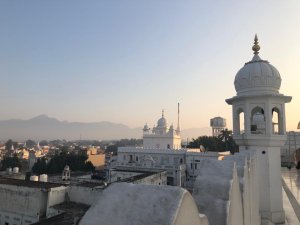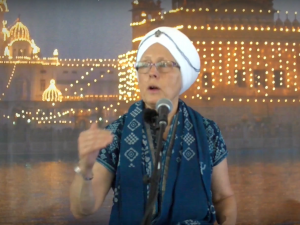One of the most defining aspects of a Sikh's life is the relationship between the Sikh and his Guru. We are by definition "Sikhs of the Guru"; those seekers and students who walk the Path of Guru Nanak. The Sikh Gurdwara Act of 1925 states that a person shall be deemed a Sikh if he declares that he believes in the Siri Guru Granth Sahib, and the Ten Gurus. Yet although the concept of "Guru" is shared by all Sikhs, the manifestation of Guru is personal and unique to each Sikh. It is common for us to express that we "trust in the Guru", that we "rely on the Guru", and that we "have faith in the Guru". This shardha, our loving devotion, is the bedrock of our dharma. But what Guru are we referring to exactly when we make these statements, and what cosmic entity is it that we heap such responsibilities on? The answer to this question reaches into the soul of the Sikh, and goes far beyond the realms of academic reason. The answer lies in our intrinsic identity; we are Sikhs of the Shabad Guru delivered to the Panth by Guru Gobind Singh.
Long before there was the Khalsa, our turban and long hair, Guru Nanak Dev ji took human birth to help guide humanity. Guru Nanak bowed to the Shabad, the essential sound current that flows through all beings that is beyond time and above space. He had no personal Guru to teach him, and the revelations that flowed through him came directly from God. In a mystical sense, Nanak was a student of the Shabad Guru. He revealed the Shabad to us as a way to know God and as a technology to reach Him. After Guru Nanak, for nearly two hundred years, Sikhs of the Guru received the blessing of the consciousness of ten divinely human incarnations of Guru. And finally, it took a human as bold and brave as Guru Gobind Singh, the 10th Sikh Guru, to return the throne of Guru to the Shabad.
Guru Gobind Singh was born on the 7th night after the new moon - Dec 22, 1666. Just as all children are reared in the laps of their mothers, the Tenth Guru grew up kicking and playing in the lap of Mata Gujri. Gobind Rai was a beautiful child, cheerful in disposition and radiant in appearance. Both Muslim and Hindu holy men came to see him calling him Bala Pritam, the "Beloved child". As he grew older, Gobind Rai transformed himself through enormous sacrifice into the King of the Sikhs, Guru Gobind Singh.
Guru Gobind Singh declared that he had come to the world with a mission to protect and help the good; and to chastise and uproot the evil-doers.
XwhI kwj Drw hm jnm?
smJ lyhu swDU sB mnm?
Drm clwvn sMq aubwrn
dust sBn ko mUl aupwirn [ôó
I took birth only for this purpose;
Understand this in your heart, O holymen!
To spread Dharma and protect the saints,
And to uproot all the demons and fiends. (43)
Guru Gobind Singhji, Bichitra Naatak - Apnee Kathaa
This could be done only by leading a warrior's life in the world, not an reclusive life in the retreats of mountains and jungles far away from people. This was the magnificence Guru Gobind Singh, both a teacher and a disciple, a saint and a soldier, a man of the world and yet detached from it.
With genius and sensitivity, Guru Gobind Singh uplifted the common people from under the horrible oppression of the fanatic Mughal regime that had gripped India. He created the brotherhood of the Khalsa, with uncut hair and turban, which gives us a unique identity even in a crowd of millions. He was a scholar of many languages and a writer of profound bani. He embodied kindness and courage, meditation and action, in one amazing man the likes of whom the world has not witnessed before or since. Guru Gobind Singh was a spiritual warrior of renowned skill, yet lived his life by the principles of love.
Guru Gobind Singh and the Khalsa fought many fierce battles against the tyrannical Mughal Emperor Aurangzeb at great personal cost to the Sikhs. In the Emperor's efforts to annihilate the Khalsa, the four beloved sons of Guru Gobind Singh were martyred; the two eldest fighting in the battle of Chamkaur, and the two youngest, ages 7 and 9, bricked alive by the evil governor Wazir Khan of Sarhund. Guru Gobind Singh gave his Sikhs the gift of chardi kala, so even through those tragic times the spirit of the Khalsa was exalted.
In 1706, Guru Gobind Singh and his Khalsa had made their camp in Talwandi Sabo, at a place known as Damdama Sahib. For the first time in years, the Khalsa was able to stay in one location without the threat of persecution. Damdama became a place of reunion, and many faithful Sikhs came here to meet with their beloved Guru.
During the evacuation of Anandpur Sahib, the holy Adi Granth Sahib had been lost in the river when the Sikhs were attacked in the night. Since the Shabad Guru must be returned to the Sikhs, Guru Gobind Singh set up a separate tent and worked long hours without interruption. Bhai Mani Singh wrote precisely while Guru Gobind Singh dictated the entire volume by memory. He added for the first time the sloks of his father, Guru Teg Bahadur.
Guru Gobind Singh and his Khalsa stayed at Damdama Sahib for nine months and nine days. Towards the end of August 1707, the Guru answered the demands of the time and shifted his royal court to Nanded, south of Mumbai. Here on the banks of the Godavari River, the Guru made camp and declared the area Abachal Nagar - the City of God.
One day in the Guru's darbar, an Afghan Pathan came to the Guru's presence and bowed low before the Guru. The Guru motioned for him to sit in the front. He sat for sometime, and when he rose to leave, the Guru gave him five rupees in charity. The next day he came again. This time Guru Gobind Singh motioned for him to sit near and asked that prashad be given to him.
That night, the Pathan crept into camp and soundlessly slipped through the watch of the Guru's bodyguard. With an evil heart, he thrust his dagger into the Guru's sleeping body. The Guru drew his sword from beside his bed and swept it forward in a mighty arc, killing the assassin with a single blow. But the Guru had already been hurt. The Guru's wounds were deep and jagged, and they bled profusely.
On hearing this tragedy, Emperor Bahadur Shah sent the best surgeon in his employ - an Englishman named Dr. Cole. So skillfully did he suture the wound that the Guru was nearly totally healed within two weeks. Bahadur Shad checked daily on the Guru's improving condition and sent him gifts and offering. One day he sent a messenger with various weapons to please the Guru, including two sturdy bows. The Guru's soldiers tried to string the handsome bows, but they were too stiff for anyone to manage. Taking the bow in hand, Guru Gobind Singh bent and strung the bow in one swift motion to the amazement of the sangat.
As he held the bow over his head for the sangat to see, a red bloodstain rapidly spread over the yellow silk of his chola. The incredible strain of bending the bow burst open the stitching of his stab wounds and he began to bleed uncontrollably. Doctors were immediately summoned, but with all their skill, they could not stop the bleeding. The invincible Guru had chosen his time to die. Having accomplished his objectives on this earth and having secured the future of the Khalsa, Guru Gobind Singh longed to return home to His eternal Lord. The Sikhs were awe-struck at what had happened so unexpectedly and were overcome with grief as they watched the life-prana slip out of the King of all kings. He counseled them not to worry, and forbade them to grieve for him.
"Oh beloved Khalsa", he said, "The immortal God's Will can never be resisted. He who takes birth must assuredly someday die."
But, they knelt at his feet and cried, "What will become of us? Who will succeed you and stand as our Guru?" The Guru replied, "I entrust you to the immortal God Himself. Ever remain under his protection alone. Wherever there are five Khalsa together, know that I am in the midst of them. He who serves them, serves me."
Going to the Siri Guru Granth Sahib, Guru Gobind Singh ji placed five pice and a coconut before the Shabad Guru. He said to his Khalsa,
AwigAw BeI Akwl kI qbI clwXo pMQ]
siB isKn ko hukm hY guru mwnIau gRMQ]
guru gRMQ jI mwinE pRgt gurwN kI dyh]
jo pRB ko imlbo chY Koj Sbd mY lyh]
The Order has come from the Undying Lord to follow the Panth.
The Order given to all Sikhs is to believe in the Siri Guru Granth Sahib as Guru.
Believe in the Siri Guru Granth Sahib, and the Guru's Blessings will be manifest.
Whoever wishes to meet me should look to the Shabad.
Giani Gian Singh, Panth Parkash, Page 353
As the great Guru left this earth, the grief and loss of the Khalsa was unendurable. But remembering the Guru's last words, they bowed before the Siri Guru Granth Sahib with total dedication and devotion.
The Shabad Guru of Guru Nanak evolved through the crystal psyche of the ten great Sikh Guru's and the Shabad once again rose as the single and uncontested Guru of the Sikhs. So the Shabad Guru reigns even today. To embrace the Shabad as your Guru, teacher, and guide takes courage and devotion. The Shabad is both practical and mystical at the same time. Much more than words on paper or spoken sounds, the Shabad is a true spiritual teacher, transforming us even beyond our personal capacity and expectations.
As explained by Siri Singh Sahib Bhai Sahib Harbhajan Singh Khalsa Yogiji, "A Guru is an active knowledge. It is not the intellectual knowledge that simply classifies or analyzes. Guru changes you. Guru develops the capacity to see. It removes darkness. The Shabad Guru transforms the practitioner by removing the barriers erected by the needs of the ego. It gives you Know How, not just Know What. It gives you procedural knowledge that is in your cells and your subconscious, not just the representational knowledge in your ideas.
"To encounter the Shabad Guru is to learn by doing, by experience, by engaging in a practice. The key practice for Shabad Guru is meditation and repetition. That may seem simple, but simple does not necessarily mean easy or without challenge. The greatest challenge is the practitioner's own subconscious. The mind is not trained to base itself in relationship to the Infinite. It is based in ego. It is filled with reactive thoughts that try to maintain the attachments of the ego.
jb iehu mn mih krq gumwnw ]
qb iehu bwvru iPrq ibgwnw ]
jb iehu hUAw sgl kI rInw ]
qw qy rmeIAw Git Git cInw ]1]
shj suhylw Plu mskInI ]
siqgur ApunY moih dwnu dInI ]1]
When this mind is filled with pride,
then it wanders around like a madman and a lunatic.
But when it becomes the dust of all,
then it recognizes the Lord in each and every heart. || 1 ||
The fruit of humility is intuitive peace and pleasure.
My True Guru has given me this gift
Guru Arjan Devji Siri Guru Granth Sahib page 235
"When you repeat the patterns of sound and thought in a Shabad, those thoughts counter the direction and intensity of the habitual thoughts. The Shabad provokes a release of the stored subconscious patterns of thinking and feeling. If, under the torrential flood of subconscious feelings and thoughts, you persist in repeating the pattern of the Shabad Guru, then a new pattern establishes itself. Your mind clears, and you awaken dormant inner capacities or enhance existing ones.
"From where do the patterns of the Shabad Guru come? They have existed from the beginning of creation. They are the tides and rhythms of the movement of the creative pulse of Infinite Consciousness. They vibrate in all things continually.
"It is only the ability to hear and feel them that is needed. This capacity comes to a mind that is fearless, neutral, open, and awakened. The Ten Gurus of the Sikh path heard the Shabad perfectly. They put that rhythm and pattern of energy in to the poetic composition of the Siri Guru Granth Sahib. That is why it is called a Granth rather than just a collection. Granth means "knot". It is a knot that binds the pattern of awareness into the words of song. Each Shabad is a template for an aspect of awareness and a potential of consciousness. Each Shabad is like a spiritual DNA that naturally restructures the mind and stimulates the brain."1
As we remember the blessed occasion of Guru Gobind Singh's birth, we salute the beginning of the 2008 and the tercentenary of the Siri Guru Granth Sahib's Guru Gaddee. The Shabad Guru took the throne of Guru at a time in the history of humans when only a vibration as pure and penetrating as the Shabad could endure the cold brutality of modern life. Shabad Guru is the Guru of the Age, delivered by the hand of the great Guru Gobind Singh.
"Time itself is shaking us, demanding we wake up and change. Like the insistent hand of Wahe Guru, it shakes us out of sleep. Time does not stay steady. It changes like the seasons. The message and technology of the Shabad Guru is essential for now and for the future. "2
------------------------------------------
1 Yogi Bhajan, KRI International Teacher Training Manual, page 71
2 Siri Singh Sahib Bhai Sahib Harbhajan Singh Khalsa Yogiji, Shabd Guru - Quantum Technology for Awareness, 1995






